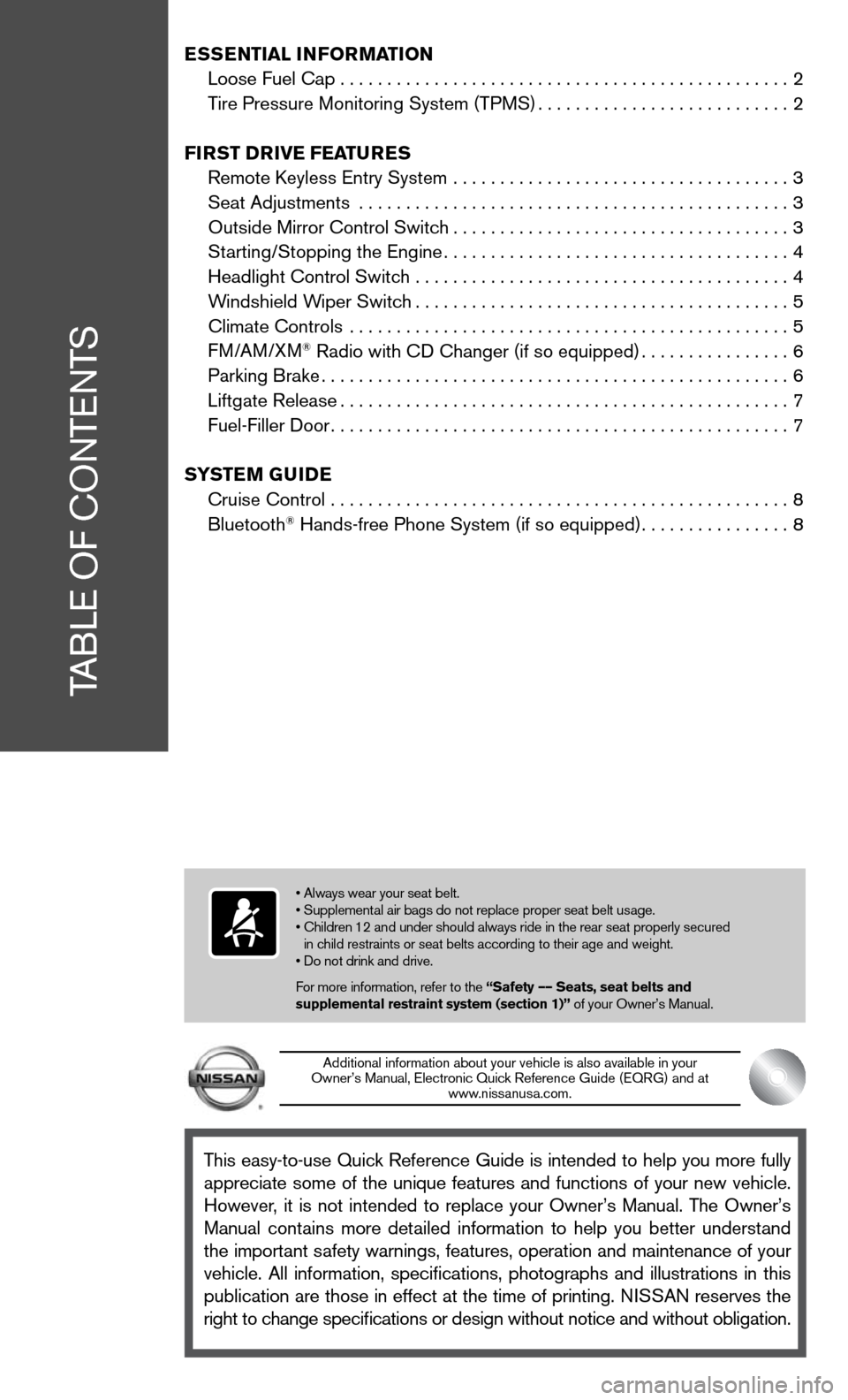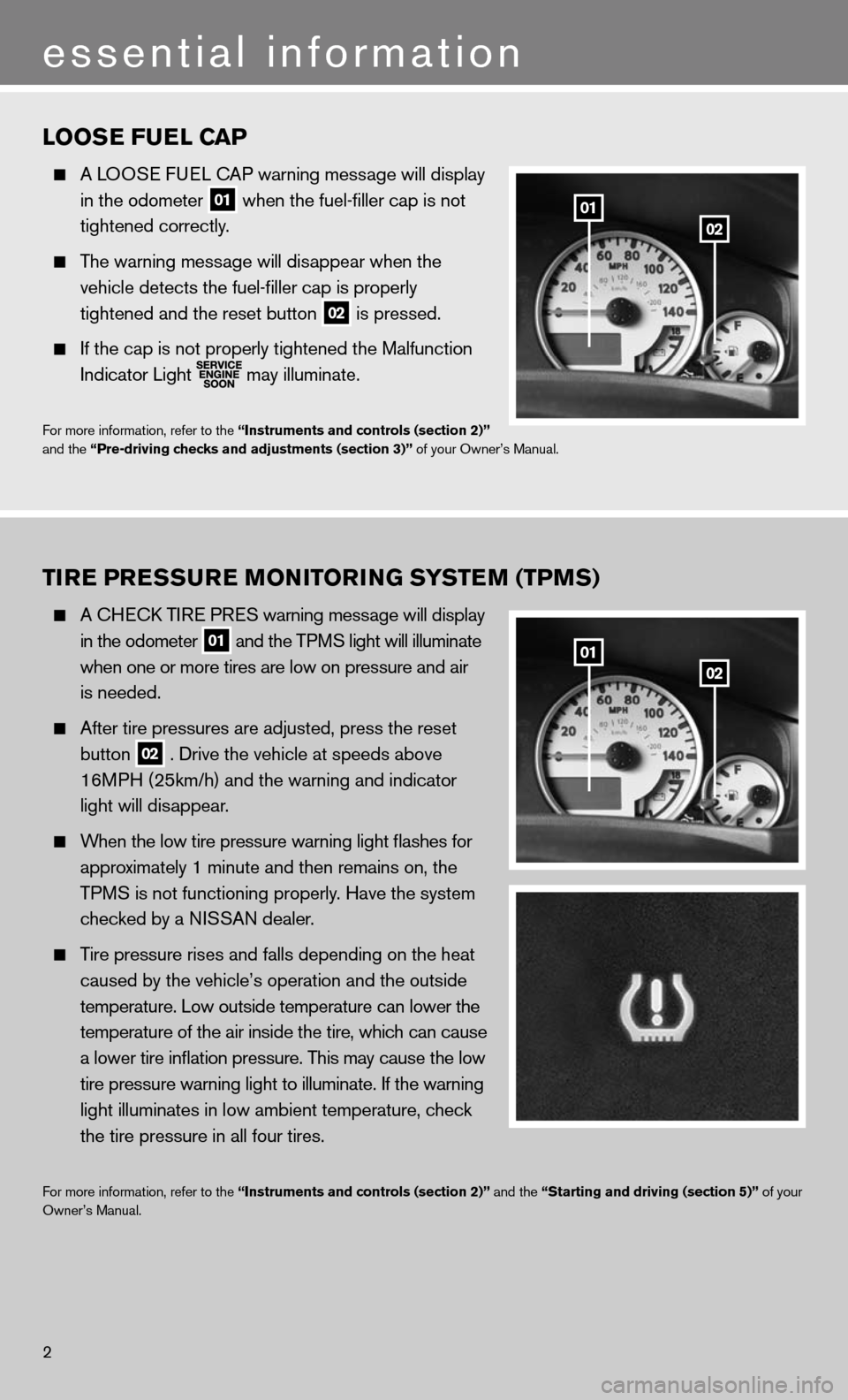TPMS NISSAN XTERRA 2011 N50 / 2.G Quick Reference Guide
[x] Cancel search | Manufacturer: NISSAN, Model Year: 2011, Model line: XTERRA, Model: NISSAN XTERRA 2011 N50 / 2.GPages: 12, PDF Size: 0.67 MB
Page 3 of 12

This easy-to-use Quick Reference Guide is intended to help you more fully
appreciate some of the unique features and functions of your new vehicle.
However, it is not intended to replace your Owner’s Manual. The Owner’s
Manual contains more detailed information to help you better understand
the important safety warnings, features, operation and maintenance of your
vehicle. All information, specifications, photographs and illustrations in this
publication are those in effect at the time of printing. niSSA n reserves the
right to change specifications or design without notice and without obligation.
TABLe O f cOnTenTS
Additional information about your vehicle is also available in your
Owner’s Manual, electronic Quick Reference Guide ( eQRG) and at
www.nissanusa.com.
Ess Ential i nformation
Loose fuel cap . . . . . . . . . . . . . . . . . . . . . . . . . . . . . . . . . . . .\
. . . . . . . . . . . . 2
Tire Pressure Monitoring System (TPMS) ...........................2
first DrivE fEatur Es
Remote k eyless entry System .................................... 3
Seat Adjustments .............................................. 3
Outside Mirror control Switch .................................... 3
Starting/Stopping the engine ..................................... 4
Headlight control Switch ........................................ 4
Windshield Wiper Switch ........................................ 5
climate controls ............................................... 5
f M/AM/XM
® Radio with cd changer (if so equipped) ................6
Parking Brake .................................................. 6
Liftgate Release ................................................ 7
fuel-filler door ................................................. 7
s ystE m Gui DE
cruise control ................................................. 8
Bluetooth
® Hands-free Phone System (if so equipped) ................8
• Always wear your seat belt.
• Supplemental air bags do not replace proper seat belt usage.
• Children 12 and under should always ride in the rear seat properly secured
in child restraints or seat belts according to their age and weight.
• Do not drink and drive.
for more information, refer to the “ safety –– seats, seat belts and
supplemental restraint system (section 1)” of your Owner’s Manual.
Page 4 of 12

loosE fuEl C aP
A L OOS e fueL cAP warning message will display
in the odometer
01 when the fuel-filler cap is not
tightened correctly.
The warning message will disappear when the
vehicle detects the fuel-filler cap is properly
tightened and the reset button
02 is pressed.
i f the cap is not properly tightened the Malfunction
indicator Light
may illuminate.
f
or more information, refer to the “instruments and controls (section 2)”
and the “Pre-driving checks and adjustments (section 3)” of your Owner’s Manual.
2
essential information
0201
tir E Pr Essur E monitorin G systEm (tPms)
A c Heck Ti Re PR eS warning message will display
in the odometer
01 and the TPMS light will illuminate
when one or more tires are low on pressure and air
is needed.
After tire pressures are adjusted, press the reset
button
02 .
d rive the vehicle at speeds above
16MPH (25km/h) and the warning and indicator
light will disappear.
When the low tire pressure warning light flashes for
approximately 1 minute and then remains on, the
TPMS is not functioning properly. Have the system
checked by a ni SSAn dealer.
Tire pressure rises and falls depending on the heat
caused by the vehicle’s operation and the outside
temperature. Low outside temperature can lower the
temperature of the air inside the tire, which can cause
a lower tire inflation pressure. This may cause the low
tire pressure warning light to illuminate. if the warning
light illuminates in low ambient temperature, check
the tire pressure in all four tires.
for more information, refer to the “instruments and controls (section 2)” and the “starting and driving (section 5)” of your
Owner’s Manual.
0201